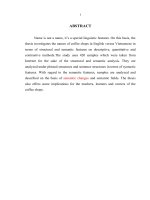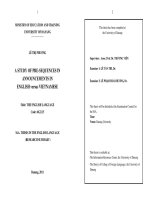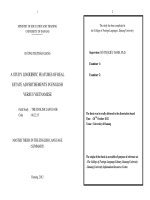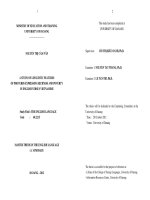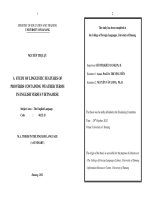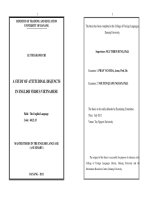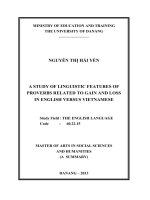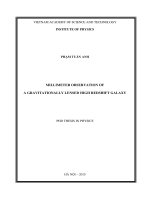A cognitive study of expressions of metaphor of love in English versus Vietnamese (Luận án tiến sĩ)
Bạn đang xem bản rút gọn của tài liệu. Xem và tải ngay bản đầy đủ của tài liệu tại đây (1.71 MB, 235 trang )
MINISTRY OF EDUCATION AND TRAINING
UNIVERSITY OF DANANG
HỒ TRỊNH QUỲNH THƯ
A COGNITIVE STUDY OF EXPRESSIONS OF
METAPHOR OF LOVE IN ENGLISH VERSUS
VIETNAMESE
DOCTORAL THESIS
IN SOCIAL SCIENCES AND HUMANITIES
Da Nang, 2018
MINISTRY OF EDUCATION AND TRAINING
UNIVERSITY OF DANANG
HỒ TRỊNH QUỲNH THƯ
A COGNITIVE STUDY OF EXPRESSIONS OF
METAPHOR OF LOVE IN ENGLISH VERSUS
VIETNAMESE
Major: ENGLISH LINGUISTICS
Code: 62.22.02.01
DOCTORAL THESIS
IN SOCIAL SCIENCES AND HUMANITIES
SUPERVISOR: Assoc.Prof. Dr. Phan Văn Hòa
Da Nang, 2018
i
STATEMENT OF AUTHORSHIP
Except where bibliography is made in the text, the dissertation contains no
material published elsewhere or extracted in whole or in part from another author’s
thesis or document. It does not comprise any parts by which I have qualified for or
been awarded another degree or diploma.
This dissertation is also assured that it has not been submitted for the award of
any degree or diploma in any other tertiary institution.
Da Nang, January 2018
Hồ Trịnh Quỳnh Thư
ii
ABSTRACT
The dissertation is carried out in the light of the conceptual metaphor theory
fathered by Lakoff and Johnson (1980). It aims at investigating and comparing the
expressions of metaphor of romantic love in three linguistic dimensions- space, time
and sensory perceptions- of English and Vietnamese modern poetry. The study uses
the metaphor identification procedures raised by Charteris Black (2004), Pragglejaz
Group (2007) and Steen (1999) to minimize the mistakes and increase the believability
of its results of linguistic and conceptual metaphor identification. Besides,
technological tools, namely SPSS20 and Microsoft Excel 2013, are also applied to the
analysis process of 3300 samples (1650 in each language) collected from 547 love
poems. The finding is that love is conceptualized in terms of 21 conceptual metaphors
in English and Vietnamese. Especially, one more source domain that is used for love
in Vietnamese but not uncovered in our English data is sight. It is one of the
differences found between English and Vietnamese conceptualization of love via the
language of space, time and sensory perceptions. Interestingly, 7 of 22 these source
domains are considered partly or wholly new, including climate, drug, life, music,
sight, source of energy, and time. Besides, the expressions of metaphor of love are
also determined both conventional and novel. The novelty is manifested via four
techniques- extending, elaboration, questioning, and combination, which once again
proves the creativity and imaginativeness in poetic language. In addition, the study
also finds it that not only the conceptual metaphors but the spatial, temporal and
sensory terms used to express love are similar between English and Vietnamese. The
similarities may result from the universality of conceptual metaphor and the
objectiveness of natural world. However, language is a cultural factor and directly
under the effects of culture. Metaphor is the reflection of individual thoughts and
experiences. As a result, the ways to express love identified in our study are different
between these two languages.
iii
TABLE OF CONTENTS
STATEMENT OF AUTHORSHIP ................................................................................. i
ABSTRACT ........................................................................................................................ii
TABLE OF CONTENTS ................................................................................................ iii
ABBREVIATIONS AND TYPOGRAPHICAL CONVENTIONS....................... viii
LIST OF THE TABLES ..................................................................................................ix
LIST OF THE FIGURES ................................................................................................xi
CHAPTER 1. INTRODUCTION.................................................................................... 1
1.1. Rationale ....................................................................................................................... 1
1.2. Aims and objectives of the study .............................................................................. 4
1.2.1. Aims of the study .......................................................................................4
1.2.2. Objectives of the study ..............................................................................4
1.3. Research questions ...................................................................................................... 4
1.4. Focus and scope of the study ..................................................................................... 5
1.4.1. Focus of the study .....................................................................................5
1.4.2. Scope of the study .....................................................................................6
1.5. Justification for the study .......................................................................................... 7
1.5.1. Theoretical significance of the study ........................................................7
1.5.2. Practical significance of the study ...........................................................8
1.6. Organization of the study........................................................................................... 9
1.7. Summary ....................................................................................................................11
CHAPTER 2. LITERATURE REVIEW AND THEORETICAL BACKGROUND
.............................................................................................................................................13
2.1. Theoretical background ...........................................................................................13
2.1.1. The conceptual metaphor theory (CMT) ................................................14
2.1.1.1. The systematicity of conceptual metaphors ....................................14
2.1.1.2. Partialness of conceptual metaphors. ..............................................15
iv
2.1.1.3. Metaphorical coherence and understanding ...................................16
2.1.1.4. Cognitive mechanism of conceptual metaphors .............................18
2.1.1.5. Types of conceptual metaphors ......................................................19
2.1.1.6. Limitations of the CMT ..................................................................20
2.1.2. Recent development in conceptual metaphor .........................................21
2.1.2.1. Categorization view of metaphor ....................................................22
2.1.2.2. Blending theory of metaphor ..........................................................22
2.1.2.3. Neural theory of metaphor ..............................................................24
2.1.2.4. The view based on the main meaning focus ...................................25
2.1.3. Expression of metaphor ..........................................................................26
2.1.4. Metaphor and culture .............................................................................26
2.1.5. Metaphor in literature and in poetry ......................................................27
2.1.6. Concepts of space, time and sensory perceptions ..................................31
2.1.6.1. Space ...............................................................................................31
2.1.6.2. Time ................................................................................................32
2.1.6.3. Sensory perception ..........................................................................32
2.1.7. Love as an emotion .................................................................................33
2.1.8. Conceptual metaphors of love ................................................................34
2.2. Previous studies of metaphors of love ....................................................................37
2.3. Summary ....................................................................................................................42
CHAPTER 3. METHODOLOGY ................................................................................44
3.1. Research design .........................................................................................................44
3.1.1. Inductive approach .................................................................................44
3.1.2. Qualitative and quantitative methods ....................................................45
3.1.3. Descriptive and contrastive methods .....................................................46
v
3.1.3.1. Descriptive method .........................................................................46
3.1.3.2. Contrastive method .........................................................................47
3.2. Data collection............................................................................................................47
3.2.1. Sources of data .......................................................................................48
3.2.2. Identification of linguistic metaphors ....................................................49
3.2.2.1 Charteris-Black’s method ................................................................50
3.2.2.2 MIP and MIPVU ..............................................................................51
3.2.3. Identification of conceptual metaphors ..................................................54
3.2.4. Identification of novel metaphors of love ...............................................55
3.3. Data analysis ..............................................................................................................56
3.3.1. Statistical analysis tool ...........................................................................56
3.3.2. Data analysis procedure ........................................................................60
3.4. Summary ....................................................................................................................62
CHAPTER 4. EXPRESSIONS OF METAPHOR OF LOVE IN ENGLISH
POETRY ............................................................................................................................63
4.1. General description ...................................................................................................63
4.2. English spatial language used to express love.......................................................65
4.2.1. English terms of location used to express love ......................................65
4.2.2. English terms of configuration used to express love ..............................69
4.2.3. English terms of movement used to express love ...................................72
4.3. English temporal language used to express love ..................................................76
4.3.1. English chronological terms used to express love .................................76
4.3.2. English kairotic terms used to express love ...........................................79
4.4. English sensory language used to express love .....................................................84
4.4.1. English terms of visual perception used to express love ........................84
4.4.2. English terms of tactile perception used to express love .......................87
vi
4.4.3. English terms of gustatory perception used to express love ..................91
4.4.4. English terms of olfactory perception used to express love ...................93
4.4.5. English terms of auditory perception used to express love ....................94
4.5. Novelty of love metaphors in English poetry ........................................................97
4.5.1. Novelty of conceptual metaphors of love in English poetry ...................97
4.5.2. Novel use of love metaphors in English poetry ......................................99
4.6. Summary ..................................................................................................................102
CHAPTER 5. EXPRESSIONS OF METAPHOR OF LOVE IN VIETNAMESE
POETRY ........................................................................................��������������������������������������������������������������������������������������������������������������������������������������������������������������������������������������������������������������������������������������������������������������������������������������������������������������������������������������������������������������������������������������������������������������������������������������������������������������������������������������������������������������������������������������������������������������������������������������������������������������������������������������������������������������������������������������������������������������������������������������������������������������������������������������������������������������������������������������������������������������������������������������������������������������������������������������������������������������������������������������������������������������������������������������������������������������������������������������������������������������������������������������������������������������������������������������������������������������������������������������������������������������������������������������������������������������������������������������������������������������������������������������������������������������������������������������������������������������������������������������������������������������������������������������������������������������������������������������������������������������������������������������������������������������������������������������������������������������������������������������������������������������������������������������������������������������������������������������������������������������������������������������������������������������������������������������������������������������������������������������������������������������������������������������������������������������������������������������������������������������������������������������������������������������������������������������������������������������������������������������������������������������������������������������������������������������������������������������������������������������������������������������������������������������������������������������������������������������������������������������������������������������������������������������������������������������������������������������������������������������������������������������������������������������������������������������������������������������������������������������������������������������������������������������������������������������������������������������������������������������������������������������������������������������������������������������������������������������������������������������������������������������������������������������������������������������������������������������������������������������������������������������������������������������������������������������������������������������������������������������������������������������������������������������������������������������������������������������������������������������������������������������������������������������������������������������������������������������������������������������������������������������������������������������������������������������������������������������������������������������������������������������������������������������������������������������������������������������������������������������������������������������������������������������������������������������������������������������������������������������������������������������������������������������������������������������������������������������������������������������������������������������������������������������������������������������������������������������������������������������������������������������������������������������������������������������������������������������������������������������������������������������������������������������������������������������������������������������������������������������������������������������������������������������������������������������������������������������������������������������������������������������������������������������������������������������������������������������������������������������������������������������������������������������������������������������������������������������������������������������������������������������������������������������������������������������������������������������������������������������������������������������������������������������������������������������������������������������������������������������������������������������������������������������������������������������������������������������������������������������������������������������������������������������������������������������������������������������������������������������������������������������������������������������������������������������������������������������������������������������������������������������������������������������������������������������������������������������������������������������������������������������������������������������������������������������������������������������������������������������������������������������������������������������������������������������������������������������������������������������������������������������������������������������������������������������������������������������������������������������������������������������������������������������������������������������������������������������������������������������������������������������������������������������������������������������������������������������������������������������������������������������������������������������������������������������������������������������������������������������������������������������������������������������������������������������������������������������������������������������������������������������������������������������������������������������������������������������������������������������������������������������������������������������������������������������������������������������������������������������������������������������������������������������������������������������������������������������������������������������������������������������������������������������������������������������������������������������������������������������������������������������������������������������������������������������������������������������������������������������������������������������������������������������������������������������������������������������������������������������������������������������������������������������������������������������������������������������������������������������������������������������������������������������������������������������������������������������������������������������������������������������������������������������������������������������������������������������������������������������������������������������������������������������������������������������������������������������������������������������������������������������������������������������������������������������������������������������������������������������������������������������������������������������������������������������������������������������������������������������������������������������������������������������������������������������������������������������������������������������������������������������������������������������������������������������������������������������������������������������������������������������������������������������������������������������������������������������������������������������������������������������������������������������������������������������������������������������������������������������������������������������������������������������������������������������������������������������������������������������������������������������������������������������������������������������������������������������������������������������������������������������������������������������������������������������������������������������������������������������������������������������������������������������������������������������������������������������������������������������������������������������������������������������������������������������������������������������������������������������������������������������������������������������������������������������������������������������������������������������������������������������������������������������������������������������������������������������������������������������������������������������������������������������������������������������������������������������������������������������������������������������������������������������������������������������������������������������������������������������������������������������������������������������������������������������������������������������������������������������������������������������������������������������������������������������������������������������������������������������������������������������������������������������������������������������������������������������������������������������������������������������������������������������������������������������������������������������������������������������������������������������������������������������������������������������������������������������������������������������������������������������������������������������������������������������������������������������������������������������������������������������������������������������������������������������������������������������������������������������������������������������������������������������������������������������������������������������������������������������������������������������������������������������������������������������������������������������������������������������������������������������������������������������������������������������������������������������������������������������������������������������������������������������������������������������������������������������������������������������������������������������������������������������������������������������������������������������������������������������������������������������������������������������������������������������������������������������������������������������������������������������������������������������������������������������������������������������������������������������������������������������������������������������������������������������������������������������������������������������������������������������������������������������������������������������������������������������������������������������������������������������������������������������������������������������������������������������������������������������������������������������������������������������������������������������������������������������������������������������������������������������������������������������������������������������������������������������������������������������������������������������������������������������������������������������������������������������������������������������������������������������������������������������������������������������������������������������������������������������������������������������������������������������������������������������������������������������������������������������������������������������������������������������������������������������������������������������������������������������������������������������������������������������������������������������������������������������������������������������������������������������������������������������������������������������������������������������������������������������������������������������������������������������������������������������������������������������������������������������������������������������������������������������������������������������������������������������������������������������������������������������������������������������������������������������������������������������������������������������������������������������������������������������������������������������������������������������������������������������������������������������������������������������������������������������������������������������������������������������������������������������������������������������������������������������������������������������������������������������������������������������������������������������������������������������������������������������������������������������������������������������������������������������������������������������������������������������������������������������������������������������������������������������������������������������������������������������������������������������������������������������������������������������������������������������������������������������������������������������������������������������������������������������������������������������������������������������������������������������������������������������������������������������������������������������������������������������������������������������������������������������������������������������������������������������������������������������������������������������������������������������������������������������������������������������������������������������������������������������������������������������������������������������������������������������������������������������������������������������������������������������������������������������������������������������������������������������������������������������������������������������������������������������������������������������������������������������������������������������������������������������������������������������������������������������������������������������������������������������������������������������������������������������������������������������������������������������������������������������������������������������������������������������������������������������������������������������������������������������������������������������������������������������������������������������������������������������������������������������������������������������������������������������������������������������������������������������������������������������������������������������������������������������������������������������������������������������������������������������������������������������������������������������������������������������������������������������������������������������������������������������������������������������������������������������������������������������������������������������������������������������������������������������������������������������������������������������������������������������������������������������������������������������������������������������������������������������������������������������������������������������������������������������������������������������������������������������������������������������������������������������������������������������������������������������������������������������������������������������������������������������������������������������������������������������������������������������������������������������������������������������������������������������������������������������������������������������������������������������������������������������������������������������������������������������������������������������������������������������������������������������������������������������������������������������������������������������������������������������������������������������������������������������������������������������������������������������������������������������������������������������������������������������������������������������������������������������������������������������������������������������������������������������������������������������������������������������������������������������������������������������������������������������������������������������������������������������������������������������������������������������������������������������������������������������������������������������������������������������������������������������������������������������������������������������������������������������������������������������������������������������������������������������������������������������������������������������������������������������������������������������������������������������������������������������������������������������������������������������������������������������������������������������������������������������������������������������������������������������������������������������������������������������������������������������������������������������������������������������������������������������������������������������������������������������������������������������������������������������������������������������������������������������������������������������������������������������������������������������������������������������������������������������������������������������������������������������������������������������������������������������������������������������������������������������������������������������������������������������������������������������������������������������������������������������������������������������������������������������������������������������������������������������������������������������������������������������������������������������������������������������������������������������������������������������������������������������������������������������������������������������������������������������������������������������������������������������������������������������������������������������������������������������������������������������������������������������������������������������������������������������������������������������������������������������������������������������������������������������������������������������������������������������������������������������������������������������������������������������������������������������������������������������������������������������������������������������������������������������������������������������������������������������������������������������������������������������������������������������������������������������������������������������������������������������������������������������������������������������������������������������������������������������������������������������������������������������������������������������������������������������������������������������������������������������������������������������������������������������������������������������������������������������������������������������������������������������������������������������������������������������������������������������������������������������������������������������������������������������������������������������������������������������������������������������������������������������������������������������������������������������������������������������������������������������������������������������������������������������������������������������������������������������������������������������������������������������������������������������������������������������������������������������������������������������������������������������������������������������������������������������������������������������������������������������������������������������������������������������������������������������������������������������������������������������������������������������������������������������������������������������������������������������������������������������������������������������������������������������������������������������������������������������������������������������������������������������������������������������������������������������������������������������������������������������������������������love is expressed via language. Many
linguistic studies have been carried out to learn about the way to express the
experiences of this feeling. They have discussed the love expressions in many
different senses. In this thesis, only expressions of metaphor of romantic love are
chosen for our investigation for some following reasons.
First, romantic love is a complex of attitudes, a complex sentiment involving
erotic, cognitive, emotional and behavioral components which are difficult, if not
impossible, to disentangle (Bartels & Zeki, 2004; Sternberg, 1988). Hence, studying
romantic love means studying a sentiment with several components, which is an
interesting challenge facing researchers who decide to study this kind of love.
Second, expressions of metaphor of romantic love are plentiful and
diversified. It is common knowledge that love captures the attention of many
researchers for its complexity, abstraction and being difficult to define literally.
Kovecses (2000) supposed that for lack of an adequate vocabulary to clearly explicate
and discuss the abstract idea of love, our language utilizes metaphors that draw from
concrete experience as a means to relate this emotion in understandable terms. The
concept of love, especially romantic love, is thus perhaps the most highly
6
“metaphorized” emotion concept because it is not only an emotion but a relationship
as well (Kovecses, 2000, p.27).
Besides, romantic love is regarded as one of the endless inspirations of writers,
particularly poets, as a catalyst thanks to which their works are more tender and
attractive. This kind of affection is expressed or described depending on the writers’
thought and experiences. Accordingly, it may be believed that poetical works provide
our investigation with a considerably rich source of expressions of metaphor of
romantic love. It is the reason why our study just deals with the expressions of
metaphor of romantic love collected from English and Vietnamese poetry.
1.4.2. Scope of the study
The study focuses on investigating and analysing English and Vietnamese
metaphorical expressions of romantic love which are classified into three categories:
space, time and sensory perceptions. Then, they are compared to draw out the
similarities and differences between these two languages. Therefore, the issues that
are concerned with our study are determined and limited as follows.
Firstly, except romantic love, the metaphorical expressions of other love kinds
such as familial love, love of friends, religious love, and universal love are not
examined. The expression “full of love” in the lines “We're a proud family/ [...]
Happy/ full of love” (Walton, A Mountain Family Full of Love), for example, is not
collected for our investigation because it expresses familial love.
Secondly, the expressions of metaphor of romantic love must be arranged into
one of three categories: space, time and sensory perceptions, which are defined in
2.1.6. If they cannot meet this criterion, they are not chosen. For example, although
the terms “intoxication”, “drunk” and “high” in “Intoxication, you're pure
intoxication./ To me, you're like a drug./ I get, drunk, high off you.” (Gardiner,
Intoxication) are applied to express romantic love, they are not selected for our
investigation because they do not belong to any of three categories: space, time, or
sensory perceptions.
Luận án đủ ở file: Luận án full
